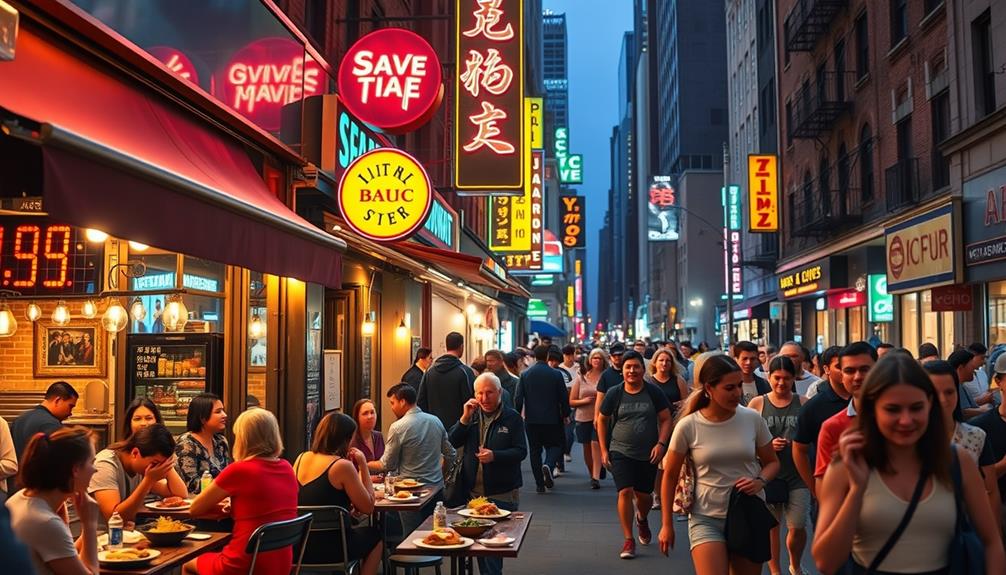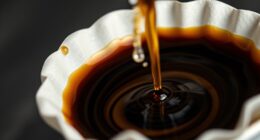Choosing the right color for your restaurant's exterior is essential for making a great first impression. Bright colors like red and yellow attract attention and create a lively atmosphere, perfect for casual dining. If you want a more relaxing vibe, consider using greens, which promote calmness and wellness. Earthy tones also work well, especially for organic or comfort food establishments. Make sure that your color choice aligns with your brand identity and local trends for maximum impact. Keep in mind that your color scheme can greatly affect customer mood and behavior, so there's more to explore on this topic.
Key Takeaways
- Bright colors like red and yellow can attract attention and increase foot traffic for casual dining establishments.
- Earthy tones create a welcoming atmosphere, ideal for restaurants focusing on organic or health-oriented concepts.
- Neutral colors foster calmness and sophistication, suitable for upscale dining environments.
- Darker shades enhance intimacy, making them perfect for bars and trendy eateries.
- Incorporating biophilic design elements and greenery can improve aesthetics and customer well-being, aligning with sustainability trends.
Importance of Exterior Color

Choosing the right exterior color for your restaurant plays an essential role in shaping first impressions. When potential customers approach, the exterior paint colors can either draw them in or send them away. Bright colors often attract attention, making your restaurant stand out, while subdued tones can convey a sense of sophistication and elegance. This initial impact can considerably influence foot traffic, so it's important to make a thoughtful choice.
Additionally, consider the use of natural materials and textures, reminiscent of modern farmhouse decor trends, which can create a welcoming atmosphere that resonates with diners.
Your color scheme should also align with your brand identity. A well-chosen palette enhances recognition and helps differentiate your restaurant from competitors in a crowded market. For example, if you're located in a vibrant urban area, bold colors may suit your brand, while earthy tones could be more appropriate in a natural setting.
Don't forget to comply with local regulations and community standards, as some neighborhoods have guidelines for maintaining aesthetic cohesion.
Additionally, consider incorporating seasonal decorations or color changes to keep things dynamic. This not only enhances curb appeal but also encourages repeat customers, making your restaurant an inviting choice for diners.
Color Psychology in Dining

When you choose colors for your restaurant, think about how they can shape your customers' emotions and experiences.
Certain shades can trigger specific feelings, like warmth and excitement from reds and oranges or calmness and relaxation from greens.
Incorporating elements of coffee culture into your design can also enhance the ambiance, making it more inviting for guests.
Understanding these color associations can help you create an inviting atmosphere that enhances the overall dining experience.
Emotional Responses to Colors
Colors play an essential role in shaping your dining experience, often influencing emotions and behaviors more than you might realize. Understanding color psychology helps you choose the right hues for your restaurant exterior, enhancing emotional responses from your customers.
For instance, red isn't just a bold choice; it increases heart rates and hunger, making it perfect for fast food or casual dining spots. By integrating elements of design thinking into your color selection, you can better align your choices with user experiences and preferences.
On the other hand, yellow radiates happiness and excitement, creating a lively atmosphere. However, it mightn't suit a relaxed dining environment due to its stimulating nature.
If you aim for tranquility, green is an excellent option, associated with relaxation and comfort, ideal for health-focused establishments. Brown offers an earthy, stabilizing effect, encouraging comfort that invites repeat visits, which is especially beneficial for coffee shops and bistros.
Color Associations in Dining
Understanding color associations in dining can transform how your restaurant is perceived and experienced. The colors you choose influence not just the look of your establishment, but also the feelings and behaviors of your diners. Here are some key associations to contemplate:
- Red and Orange: These colors stimulate appetite and excitement, making them perfect for quick-service and casual dining spots where you want to enhance customer turnover.
- Green: This color evokes relaxation and well-being, ideal for health-focused restaurants that want to connect diners with organic and fresh food options.
- Yellow: Associated with happiness and energy, yellow promotes lively conversations, making it beneficial for ethnic eateries and casual dining spaces.
- Earthy Tones: Shades like brown and olive green create a warm, inviting atmosphere that appeals to diners seeking comfort and authenticity in their meals.
Using neutral colors can balance these vibrant shades, ensuring a visually appealing environment while maintaining an inviting atmosphere.
Popular Exterior Color Schemes

Choosing the right exterior color scheme for your restaurant can greatly impact its appeal and atmosphere. Popular choices often blend earthy tones like browns and greens, creating a welcoming vibe that aligns well with organic food concepts.
If you're aiming for a fast-casual dining experience, consider using bright colors such as red and yellow. These hues can attract attention and stimulate appetite, ultimately boosting customer turnover rates.
For upscale dining, neutral color schemes including whites and light grays are ideal. They foster a calm and sophisticated environment, allowing your dishes to shine.
If you're running a bar or trendy eatery, darker shades like navy or deep green can create intimacy and romance. Just be sure to balance these with bright accents to avoid a cramped feel.
If your focus is on cafes or sweet shops, pastel colors like light pinks and sky blues can promote a soft, inviting aesthetic, appealing to a diverse customer base.
Impact on Customer Behavior

The exterior color of your restaurant can profoundly impact customer behavior, often making or breaking their first impression.
The right color choices can draw in foot traffic and set the tone for your dining experience. Here are four ways color influences customers:
- Warm Colors Attract: Colors like red and yellow stimulate appetite and create an inviting atmosphere, encouraging passersby to stop in.
- Brand Recognition: Bright, eye-catching colors can increase brand recognition by up to 80%, making customers more inclined to choose your restaurant over others.
- Cohesive Color Schemes: A well-thought-out color scheme that aligns with your cuisine expectations enhances the dining experience, making customers feel they're in the right place.
- Mood Effects: Color affects mood—cooler tones can evoke relaxation, but they might also deter customers from entering, making them less effective for a dining establishment.
Trends in Exterior Design

When you're planning your restaurant's exterior, consider using sustainable materials that resonate with today's eco-conscious diners.
Incorporating biophilic design elements, like greenery and natural light, not only enhances aesthetics but also creates a welcoming atmosphere.
These trends can help your establishment stand out while connecting with your community's values.
Sustainable Material Choices
In today's restaurant landscape, embracing sustainable material choices is a game-changer for exterior design. By opting for sustainable materials, you not only minimize your environmental impact but also enhance your establishment's aesthetic appeal.
Here are some key elements to take into account:
- Reclaimed Wood: Using reclaimed wood not only adds character but also reduces demand for new lumber, making it an excellent choice for eco-conscious restaurants.
- Bamboo: This rapidly renewable resource is durable and stylish, perfect for outdoor structures or accents.
- Recycled Metal: Incorporating recycled metal elements can create a modern look while keeping waste out of landfills.
- Eco-Friendly Finishes: Choose low-VOC paints and stains to reduce harmful emissions and create a healthier environment for your patrons.
Incorporating these sustainable materials not only supports biophilic design principles but also improves your brand image among environmentally conscious consumers.
As you design your restaurant's exterior, remember that these choices can set you apart and contribute to a healthier planet. It’s important to consider sustainable materials and energy-efficient design elements. Incorporating greenery and outdoor seating can create a welcoming and eco-friendly atmosphere. In addition, offering fresh and healthy salad recipes can attract environmentally conscious diners who are looking for sustainable and nutritious options. By making thoughtful choices in your restaurant’s exterior design and menu offerings, you can contribute to a more sustainable and healthier planet.
Biophilic Design Elements
Biophilic design elements are transforming restaurant exteriors into vibrant, nature-inspired spaces that invite customers in. By incorporating natural materials and greenery, you can create a welcoming environment that enhances customer well-being and fosters a connection to nature.
Think about using plants, living walls, and outdoor gardens in your design. These features not only improve aesthetics but also contribute to better air quality and increased customer satisfaction.
Large windows or skylights can help bring in natural light, creating a bright atmosphere that encourages patrons to enjoy dining outdoors. Research shows that biophilic design can greatly increase customer dwell time and spending, as it fosters a calming and enjoyable environment.
Additionally, restaurants that embrace biophilic elements often attract a more eco-conscious clientele, aligning with current trends toward sustainability and organic dining experiences.
By integrating these design principles into your restaurant exteriors, you'll not only enhance visual appeal but also build a strong connection with your customers, making them more likely to return.
Tips for Choosing Colors

Choosing the right colors for your restaurant's exterior can greatly impact its appeal and atmosphere. The colors you select shouldn't only attract customers but also complement your restaurant's architectural style and surrounding environment.
Here are some tips to help you decide:
- Assess Architectural Style: Choose exterior colors that enhance your restaurant's design. For instance, modern establishments may benefit from bold, vibrant colors, while traditional styles might look better with neutral shades.
- Consider Surroundings: Opt for earthy tones if you're in a natural setting, and brighter colors in urban areas to create a visual harmony with the landscape.
- Evaluate Local Trends: Research local color schemes and the aesthetics of neighboring buildings. This guarantees your restaurant stands out while fitting into the community.
- Test Paint Samples: Before committing, apply paint samples on your restaurant's facade. This will help you visualize how different exterior colors interact with natural light and other design elements.
Frequently Asked Questions
What Is the Best Color for the Outside of a Restaurant?
Choosing the best color for your restaurant's exterior depends on your theme and audience. Bright colors attract urban diners, while earthy tones create comfort. Always consider incorporating seasonal decor to enhance your restaurant's curb appeal.
What Colors Attract People to Restaurants?
Colors like red and yellow spark excitement and hunger, while earthy tones create a welcoming vibe. Bright hues catch attention, and darker shades foster intimacy, so choose wisely to attract your desired clientele.
What Color Should I Paint My Business Exterior?
Did you know 60% of consumers judge a business by its exterior color? When you choose a color for your business, think about your brand identity and how it blends with the surrounding environment.
What Is the Best Color Plate for Restaurants?
When choosing a color palette for your restaurant, consider warm tones to stimulate appetite, neutral shades for a cozy vibe, and earthy hues for a natural feel. Just avoid blue; it can kill the dining atmosphere.
Conclusion
Choosing the right color for your restaurant's exterior is like painting the first stroke on a blank canvas; it sets the tone for the entire dining experience. By understanding color psychology and current trends, you can create an inviting atmosphere that draws customers in and keeps them coming back. Remember, the right hue can evoke emotions and spark appetites, so don't underestimate the power of color in making a lasting impression.









